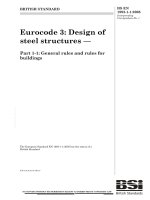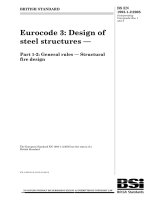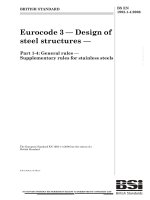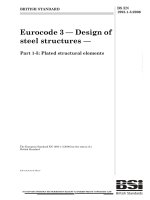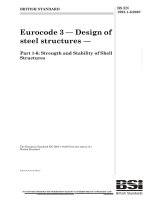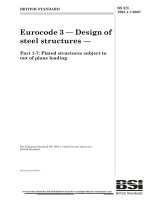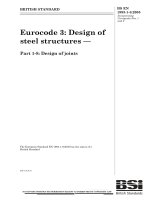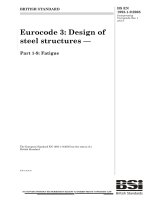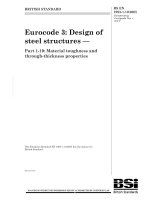Tiêu chuẩn Châu Âu EC3: Kết cấu thép phần 1.11: Cấu kiện chịu kéo (Eurocode3 BS EN1993 1 11 e 2005 Design of steel structures part 1.11: Design structure with tension component)
Bạn đang xem bản rút gọn của tài liệu. Xem và tải ngay bản đầy đủ của tài liệu tại đây (555.49 KB, 38 trang )
BRITISH STANDARD
Eurocode 3 — Design of
steel structures —
Part 1-11: Design of structures with
tension components
--```,,`,`````,,`,,``,`,,,,,`,,-`-`,,`,,`,`,,`---
The European Standard EN 1993-1-11:2006 has the status of a
British Standard
ICS 91.010.30; 91.080.10; 93.040
12 &23<,1* :,7+287 %6, 3(50,66,21 (;&(37 $6 3(50,77(' %< &23<5,*+7 /$:
BS EN
1993-1-11:2006
BS EN 1993-1-11:2006
National foreword
This British Standard was published by BSI. It is the UK implementation of
EN 1993-1-11:2006.
The UK participation in its preparation was entrusted by Technical Committee
B/525, Building and civil engineering structures, to Subcommittee B/525/31,
Structural use of steel.
A list of organizations represented on B/525/31 can be obtained on request to
its secretary.
The structural Eurocodes are divided into packages by grouping Eurocodes for
each of the main materials: concrete, steel, composite concrete and steel,
timber, masonry and aluminium; this is to enable a common date of
withdrawal (DOW) for all the relevant parts that are needed for a particular
design. The conflicting national standards will be withdrawn at the end of the
coexistence period, after all the EN Eurocodes of a package are available.
Following publication of the EN, there is a period allowed for national
calibration during which the National Annex is issued, followed by a
coexistence period of a maximum three years. During the coexistence period
Member States are encouraged to adapt their national provisions. Conflicting
national standards will be withdrawn by March 2010 at the latest. BS EN
1993-1-11 will not supersede any current British Standards. Where a
normative part of this EN allows for a choice to be made at national level, the
range and possible choice will be given in the normative text, and a note will
qualify it as a Nationally Determined Parameter (NDP). NDPs can be a specific
value for a factor, a specific level or class, a particular method or a particular
application rule if several are proposed in the EN. To enable EN 1993-1-11 to
be used in the UK, the NDPs will be published in a National Annex, which will
be made available by BSI in due course after public consultation has taken
place.
This publication does not purport to include all the necessary provisions of a
contract. Users are responsible for its correct application.
Compliance with a British Standard cannot confer immunity from
legal obligations.
--```,,`,`````,,`,,``,`,,,,,`,,-`-`,,`,,`,`,,`---
This British Standard was
published under the authority
of the Standards Policy and
Strategy Committee
on 30 November 2006
© BSI 2006
ISBN 0 580 49668 6
Amendments issued since publication
Amd. No.
Date
Comments
EUROPEAN STANDARD
EN 1993-1-11
NORME EUROPÉENNE
EUROPÄISCHE NORM
October 2006
ICS 91.010.30; 91.080.10; 93.040
Supersedes ENV 1993-2:1997
English Version
Eurocode 3 - Design of steel structures - Part 1-11: Design of
structures with tension components
Eurocode 3 - Calcul des structures en acier - Partie 1-11:
Calcul des structures à câbles ou éléments tendus
Eurocode 3 - Bemessung und Konstruktion von
Stahlbauten - Teil 1-11: Bemessung und Konstruktion von
Tragwerken mit Zuggliedern aus Stahl
This European Standard was approved by CEN on 13 January 2006.
CEN members are bound to comply with the CEN/CENELEC Internal Regulations which stipulate the conditions for giving this European
Standard the status of a national standard without any alteration. Up-to-date lists and bibliographical references concerning such national
standards may be obtained on application to the Central Secretariat or to any CEN member.
This European Standard exists in three official versions (English, French, German). A version in any other language made by translation
under the responsibility of a CEN member into its own language and notified to the Central Secretariat has the same status as the official
versions.
--```,,`,`````,,`,,``,`,,,,,`,,-`-`,,`,,`,`,,`---
CEN members are the national standards bodies of Austria, Belgium, Cyprus, Czech Republic, Denmark, Estonia, Finland, France,
Germany, Greece, Hungary, Iceland, Ireland, Italy, Latvia, Lithuania, Luxembourg, Malta, Netherlands, Norway, Poland, Portugal, Romania,
Slovakia, Slovenia, Spain, Sweden, Switzerland and United Kingdom.
EUROPEAN COMMITTEE FOR STANDARDIZATION
COMITÉ EUROPÉEN DE NORMALISATION
EUROPÄISCHES KOMITEE FÜR NORMUNG
Management Centre: rue de Stassart, 36
© 2006 CEN
All rights of exploitation in any form and by any means reserved
worldwide for CEN national Members.
B-1050 Brussels
Ref. No. EN 1993-1-11:2006: E
EN 1993-1-11: 2006 (E)
Contents
1.1
1.2
1.3
1.4
2
2.1
2.2
2.3
2.4
3
3.1
3.2
3.3
3.4
3.5
3.6
4
4.1
4.2
4.3
4.4
4.5
4.6
5
5.1
5.2
5.3
5.4
6
6.1
6.2
6.3
6.4
7
7.1
7.2
8
8.1
8.2
8.3
9
9.1
9.2
General ..................................................................................................................................................... 4
Scope ................................................................................................................................................. 4
Normative references......................................................................................................................... 5
Terms and definitions ........................................................................................................................ 6
Symbols ............................................................................................................................................. 7
Basis of design .......................................................................................................................................... 8
General .............................................................................................................................................. 8
Requirements..................................................................................................................................... 8
Actions............................................................................................................................................... 9
Design situations and partial factors................................................................................................ 11
Material .................................................................................................................................................. 11
Strength of steels and wires ............................................................................................................. 11
Modulus of elasticity ....................................................................................................................... 11
Coefficient of thermal expansion .................................................................................................... 13
Cutting to length of Group B tension components .......................................................................... 14
Lengths and fabrication tolerances .................................................................................................. 14
Friction coefficients......................................................................................................................... 14
Durability of wires, ropes and strands................................................................................................. 14
General ............................................................................................................................................ 14
Corrosion protection of individual wires......................................................................................... 15
Corrosion protection of the interior of Group B tension components ............................................. 15
Corrosion protection of the exterior of Group B tension components ............................................ 15
Corrosion protection of Group C tension components .................................................................... 16
Corrosion protection at connections ................................................................................................ 16
Structural analysis................................................................................................................................. 16
General ............................................................................................................................................ 16
Transient construction phase ........................................................................................................... 16
Persistent design situation during service........................................................................................ 17
Non-linear effects from deformations ............................................................................................. 17
Ultimate limit states............................................................................................................................... 18
Tension rod systems ........................................................................................................................ 18
Prestressing bars and Group B and C components.......................................................................... 18
Saddles............................................................................................................................................. 19
Clamps............................................................................................................................................. 22
Serviceability limit states ...................................................................................................................... 23
Serviceability criteria....................................................................................................................... 23
Stress limits ..................................................................................................................................... 23
Vibrations of cables ............................................................................................................................... 24
General ............................................................................................................................................ 24
Measures to limit vibrations of cables............................................................................................. 25
Estimation of risks........................................................................................................................... 25
Fatigue .................................................................................................................................................... 25
General ............................................................................................................................................ 25
Fluctuating axial loads..................................................................................................................... 26
Annex A (informative) Product requirements for tension components ……………………………….. 27
Annex B (informative) Transport, storage, handling …………………………………………………….30
2
--```,,`,`````,,`,,``,`,,,,,`,,-`-`,,`,,`,`,,`---
1
Page
EN 1993-1-11: 2006 (E)
Annex C (informative) Glossary …………………………………………………………………………31
Foreword
This European Standard EN 1993-1-11, Eurocode 3: Design of steel structures: Part 1-11 Design of
structures with tension components, has been prepared by Technical Committee CEN/TC250 « Structural
Eurocodes », the Secretariat of which is held by BSI. CEN/TC250 is responsible for all Structural Eurocodes.
This European Standard shall be given the status of a National Standard, either by publication of an identical
text or by endorsement, at the latest by April 2007 and conflicting National Standards shall be withdrawn
at latest by March 2010.
This Eurocode partially supersedes ENV 1993-2.
According to the CEN-CENELEC Internal Regulations, the National Standard Organizations of the
following countries are bound to implement this European Standard: Austria, Belgium, Cyprus, Czech
Republic, Denmark, Estonia, Finland, France, Germany, Greece, Hungary, Iceland, Ireland, Italy, Latvia,
Lithuania, Luxembourg, Malta, Netherlands, Norway, Poland, Portugal, Romania, Slovakia, Slovenia, Spain,
Sweden, Switzerland and United Kingdom.
National annex for EN 1993-1-11
This standard gives alternative procedures, values and recommendations with notes indicating where national
choices may have to be made. The National Standard implementing EN 1993-1-11 should have a National
Annex containing all Nationally Determined Parameters to be used for the design of tension components to
be constructed in the relevant country.
National choice is allowed in EN 1993-1-11 through:
–
2.3.6(1)
–
2.3.6(2)
–
2.4.1(1)
–
3.1(1)
--```,,`,`````,,`,,``,`,,,,,`,,-`-`,,`,,`,`,,`---
–
4.4(2)
–
4.5(4)
–
5.2(3)
–
5.3(2)
–
6.2(2)
–
6.3.2(1)
–
6.3.4(1)
–
6.4.1(1)P
–
7.2(2)
–
A.4.5.1(1)
–
A.4.5.2(1)
–
B(6)
3
EN 1993-1-11: 2006 (E)
1 General
1.1 Scope
(1) prEN1993-1-11 gives design rules for structures with tension components made of steel, which, due to
their connections with the structure, are adjustable and replaceable see Table 1.1.
NOTE: Due to the requirement of adjustability and replaceability such tension components are generally
prefabricated products delivered to site and installed into the structure. Tension components that are not
adjustable or replaceable, e.g. air spun cables of suspension bridges, or for externally post-tensioned bridges, are
outside the scope of this part. However, rules of this standard may be applicable.
(2) This standard also gives rules for determining the technical requirements for prefabricated tension
components for assessing their safety, serviceability and durability.
Table 1.1: Groups of tension components
Group Main tension element
A
rod (bar)
circular wire
B
circular and Z-wires
circular wire and stranded wire
circular wire
C
circular wire
seven wire (prestressing) strand
Component
tension rod (bar) system, prestressing bar
spiral strand rope
fully locked coil rope
strand rope
parallel wire strand (PWS)
bundle of parallel wires
bundle of parallel strands
NOTE 1: Group A products in general have a single solid round cross section connected to end terminations by
threads. They are mainly used as
–
bracings for roofs, walls, girders
–
stays for roof elements, pylons
–
tensioning systems for steel-wooden truss and steel structures, space frames
NOTE 2: Group B products are composed of wires which are anchored in sockets or other end terminations and
are fabricated primarily in the diameter range of 5 mm to 160 mm, see EN 12385-2.
Spiral strand ropes are mainly used as
–
stay cables for aerials, smoke stacks, masts and bridges
–
carrying cables and edge cables for light weight structures
–
hangers or suspenders for suspension bridges
–
stabilizing cables for cable nets and wood and steel trusses
–
hand-rail cables for banisters, balconies, bridge rails and guardrails
Fully locked coil ropes are fabricated in the diameter range of 20 mm to 180 mm and are mainly used as
–
stay cables, suspension cables and hangers for bridge construction
–
suspension cables and stabilizing cables in cable trusses
–
edge cables for cable nets
–
stay cables for pylons, masts, aerials
--```,,`,`````,,`,,``,`,,,,,`,,-`-`,,`,,`,`,,`---
4
EN 1993-1-11: 2006 (E)
Structural strand ropes are mainly used as
–
stay cables for masts, aerials
–
hangers for suspension bridges
–
damper / spacer tie cables between stay cables
–
edge cables for fabric membranes
–
rail cables for banister, balcony, bridge and guide rails.
NOTE 3: Group C products need individual or collective anchoring and appropriate protection.
Bundles of parallel wires are mainly used as stay cables, main cables for suspension bridges and external
tendons.
Bundles of parallel strands are mainly used as stay cables for composite and steel bridges.
(4)
The types of termination dealt with in this part for Group B and C products are
–
metal and resin sockets, see EN 13411-4
–
sockets with cement grout
–
ferrules and ferrule securing, see EN 13411-3
–
swaged sockets and swaged fitting
–
U-bolt wire rope grips, see EN 13411-5
–
anchoring for bundles with wedges, cold formed button heads for wires and nuts for bars.
NOTE: For terminology see Annex C.
1.2 Normative references
--```,,`,`````,,`,,``,`,,,,,`,,-`-`,,`,,`,`,,`---
(1) This European Standard incorporates dated and undated reference to other publications. These
normative references are cited at the appropriate places in the text and the publications are listed hereafter.
For dated references, subsequent amendments or revisions to any of these publications apply to this
European Standard only when incorporated in it by amendment or revision. For undated references the latest
edition of the publication referred to applies.
EN 10138 Prestressing steels
Part 1 General requirements
Part 2 Wires
Part 3 Strands
Part 4 Bars
EN 10244 Steel wire and wire products – Non-ferrous metallic coatings on steel wire
Part 1 General requirements
Part 2 Zinc and zinc alloy coatings
Part 3 Aluminium coatings
EN 10264 Steel wire and wire products – Steel wire for ropes
Part 1 General requirements
Part 2 Cold drawn non-alloyed steel wire for ropes for general applications
Part 3 Cold drawn and cold profiled non alloyed steel wire for high tensile applications
Part 4 Stainless steel wires
EN 12385 Steel wire ropes – safety
Part 1 General requirements
Part 2 Definitions, designation and classification
5
EN 1993-1-11: 2006 (E)
Part 3 Information for use and maintenance
Part 4 Stranded ropes for general lifting applications
Part 10 Spiral ropes for general structural applications
EN 13411 Terminations for steel wire ropes – safety
Part 3 Ferrules and ferrule-securing
Part 4 Metal and resin socketing
Part 5 U-bolt wire rope grips
1.3 Terms and definitions
(1)
For the purpose of this European Standard the following terms and definitions apply.
1.3.1
strand
an element of rope normally consisting of an assembly of wires of appropriate shape and dimensions laid
helically in the same or opposite direction in one or more layers around a centre
1.3.2
strand rope
an assembly of several strands laid helically in one or more layers around a core (single layer rope) or centre
(rotation-resistant or parallel-closed rope)
1.3.3
spiral rope
an assembly of a minimum of two layers of wires laid helically over a central wire
1.3.4
spiral strand rope
spiral rope comprising only round wires
1.3.5
fully locked coil rope
spiral rope having an outer layer of fully locked Z-shaped wires
1.3.6
fill factor f
the ratio of the sum of the nominal metallic cross-sectional areas of all the wires in a rope (A) and the
circumscribed area (Au) of the rope based on its nominal diameter (d)
1.3.7
spinning loss factor k
reduction factor for rope construction included in the breaking force factor K
1.3.8
breaking force factor (K)
an empirical factor used in the determination of minimum breaking force of a rope and obtained as follows:
K=
where f
π f k
4
is the fill factor for the rope
k is the spinning loss factor
NOTE: K-factors for the more common rope classes and constructions are given in the appropriate part of EN
12385.
--```,,`,`````,,`,,``,`,,,,,`,,-`-`,,`,,`,`,,`---
6
EN 1993-1-11: 2006 (E)
1.3.9
minimum breaking force (Fmin)
minimum breaking force which should be obtained as follows:
Fmin =
where d
d 2 Rr K
[kN]
1000
is the diameter of the rope in mm
K
is the breaking force factor
Rr
is the rope grade in N/mm²
1.3.10
rope grade (Rr)
a level of requirement of breaking force which is designated by a number (e.g. 1770 [N/mm²],
1960 [N/mm²])
NOTE: Rope grades do not necessarily correspond to the tensile strength grades of the wires in the rope.
1.3.11
unit weight (w)
the self weight of rope based on the metallic cross-section (Am) and the unit length taking account of the
densities of steel and the corrosion protection system
--```,,`,`````,,`,,``,`,,,,,`,,-`-`,,`,,`,`,,`---
1.3.12
cable
main tension component in a structure (e.g. a stay cable bridge) which may consist of a rope, strand or
bundles of parallel wires or strands
1.4 Symbols
(1)
For this standard the symbols given in 1.6 of EN 1993-1-1 and 1.6 of EN 1993-1-9 apply.
(2)
Additional symbols are defined where they first occur.
NOTE: Symbols may have various meanings.
7
EN 1993-1-11: 2006 (E)
2 Basis of design
2.1 General
(1)P The design of structures with tension components shall be in accordance with the general rules given
in EN 1990.
(2)
The supplementary provisions for tension components given in this standard should also be applied.
(3)
For improved durability the following exposure classes may be applied:
Table 2.1: Exposure classes
Fatigue action
no significant fatigue action
mainly axial fatigue action
axial and lateral fatigue actions
(wind & rain)
(4)
Corrosion action
not exposed
exposed externally
externally
class 1
class 2
class 3
class 4
–
class 5
Connections of tension components to the structure should be replaceable and adjustable.
2.2 Requirements
(1)P The following limit states shall be considered in designing tension components:
1. ULS:
Applied axial loads shall not exceed the design tension resistance, see section 6.
2. SLS:
Stress and strain levels in the component shall not exceed the limiting values, see
section 7.
NOTE: For durability reasons, serviceability checks may govern over ULS-verifications.
3. Fatigue: Stress ranges from axial load fluctuations and wind and rain induced oscillations shall not
exceed the limiting values, see sections 0 and 0.
NOTE: Due to the difficulties in modelling the excitation characteristics of tension elements, SLS checks
should be carried out in addition to fatigue checks.
(2) To prevent the likely de-tension of a tension component (i.e. the stress reaching below zero and
causing uncontrolled stability or fatigue or damages to structural or non structural parts) and for certain types
of structures, the tension components are preloaded by deformations imposed on the structure (prestressing).
In such cases permanent actions, which should consist of actions from gravity loads “G” and prestress “P”,
should be considered as a single permanent action “G+P” to which the relevant partial factors γGi should be
applied, see section 5.
NOTE: For other materials and methods of construction other rules for the combination of “G” and “P” may
apply.
(3) Any attachments to prefabricated tension components, such as saddles or clamps, should be designed
for ultimate limit states and serviceability limit states using the breaking strength or proof strength of cables
as actions, see section 6. For fatigue see EN 1993-1-9.
NOTE: Fatigue action on the ropes is governed by the radius in the saddle or anchorage area (see Figure 6.1 for
minimum radius).
8
--```,,`,`````,,`,,``,`,,,,,`,,-`-`,,`,,`,`,,`---
EN 1993-1-11: 2006 (E)
2.3 Actions
2.3.1
Self weight of tension components
(1) The characteristic value of the self weight of tension components and their attachments should be
determined from the cross-sectional area and the density of the materials unless data are given in the relevant
parts of EN 12385.
(2) For spiral strands, locked coil strands or structural wire ropes the nominal self weight gk may be
calculated as follows:
g k = w Am
(2.1)
where Am is the cross-section in mm² of the metallic components
[N/(mm³)] is the unit weight taking into account the density of steel including the corrosion
protection system, see Table 2.2
w
(3)
Am may be determined from
Am =
π d2
4
f
(2.2)
where d is the external diameter of rope or strand in mm, including any sheathing for corrosion protection
f
is the fill-factor, see Table 2.2
Table 2.2: Unit weight w and fill-factors f
Core
wires + 1
layer zwires
1 Spiral strand ropes
Fully locked coil
2
ropes
Circular wire
3
strand ropes
0,84
0,88
unit weight
w × 10-7
N
mm 3
830
830
0,56
930
For parallel wire ropes or parallel strand ropes the metallic cross-section may be determined from
Am = n am
(2.3)
where n is the number of identical wires or strands of which the rope is made
am is the cross-section of a wire (derived from its diameter) or a (prestressing) strand (derived from
the appropriate standard)
(5) For group C tension components the self weight should be determined from the steel weight of the
individual wires or strands and the weight of the protective material (HDPE, wax etc.)
2.3.2
(1)
Wind actions
The wind effects to be taken into account should include:
–
the static effects of wind drag on the cables, see EN 1991-1-4, including deflections and bending effects
near the ends of the cable,
–
aerodynamic and other excitation causing possible oscillation of the cables, see section 8.
9
--```,,`,`````,,`,,``,`,,,,,`,,-`-`,,`,,`,`,,`---
(4)
0,81
Fill factor f
Core
Core
Number of wire layers around
wires + 2 wires + >2
core wire
layer zlayer z1
2
3-6
>6
wires
wires
0,77
0,76
0,75
0,73
EN 1993-1-11: 2006 (E)
2.3.3
(1)
2.3.4
Ice loads
For ice loading see Annex B to EN 1993-3-1.
Thermal actions
(1) The thermal actions to be taken into account should include the effects of differential temperatures
between the cables and the structure.
(2) For cables exposed externally the actions from differential temperature should be taken into account,
see EN 1991-1-5.
2.3.5
Prestressing
(1) The preloads in cables should be such that, when all the permanent actions are applied, the structure
adopts the required geometric profile and stress distribution.
(2) Facilities for prestressing and adjusting the cables should be provided and the characteristic value of
the preload should be taken as that required to achieve the required profile in (1) at the limit state under
consideration.
(3) If adjustment of the cables is not intended to be carried out the effects of the variation of preloads
should be considered in the design of the structure.
2.3.6
Replacement and loss of tension components
(1) The replacement of at least one tension component should be taken into account in the design as a
transient design situation.
NOTE: The National Annex may define the transient loading conditions and partial factors for replacement.
(2) Where required a sudden loss of any one tension component should be taken into account in the design
as an accidental design situation.
NOTE 1: The National Annex may define where such an accidental design situation should apply and also give
the protection requirements and loading conditions, e.g. for hangers of bridges.
NOTE 2: In the absence of a rigorous analysis the dynamic effect of a sudden removal may conservatively be
allowed for by using the additional action effect Ed:
where
k = 1,5
Ed1 represents the design effects with all cables intact;
Ed2 represents the design effects with the relevant cable removed.
2.3.7
(1)
10
Fatigue loads
For fatigue loads see EN 1991.
(2.4)
--```,,`,`````,,`,,``,`,,,,,`,,-`-`,,`,,`,`,,`---
Ed = k Ed2 - Ed1
EN 1993-1-11: 2006 (E)
2.4 Design situations and partial factors
2.4.1
Transient design situation during the construction phase
(1) For the construction phase the partial factor for permanent loads may be amended to suit the particular
design situation and limit state model.
NOTE: The National Annex may define the partial factor γGi for the construction phase. Recommended values
γGi are:
γG = 1,10
for a short time period (only a few hours) for the installation of first strand in strand by strand
installations
γG = 1,20
for the installation of other strands
γG = 1,00
for favourable effects.
2.4.2
(1)
Persistent situations during service
For ULS, SLS and fatigue verifications partial factors γM may be based on
–
the severity of the conditions used for proving tests
–
the measures employed to suppress bending effects.
NOTE: Appropriate values for γM are given in section 6.
3 Material
3.1 Strength of steels and wires
(1) The characteristic values fy and fu for structural steel and f0,2 or f0,1 and fu for wires should be taken
from the relevant technical specifications.
NOTE 1: For steel see EN1993-1-1 and EN1993-1-4.
NOTE 2: For wires see EN 10264, Part 1 to Part 4.
NOTE 3: For ropes see EN 12385, Part 4 and Part 10.
NOTE 4: For terminations see EN 13411-3.
NOTE 5: For strands see EN 10138-3.
NOTE 6: The National Annex may give a maximum value for fu for durability reasons. The following values
are recommended:
–
–
steel wires
stainless steel wires:
round wires:
nominal tensile strength: 1770 N/mm²
Z-wires:
nominal tensile strength: 1570 N/mm²
round wires:
nominal tensile strength: 1450 N/mm²
3.2 Modulus of elasticity
3.2.1
Group A tension components
(1) The modulus of elasticity for Group A tension components may be taken as E = 210000 N/mm²; for
systems made of stainless steels see EN 1993-1-4.
3.2.2
(1)
Group B tension components
The modulus of elasticity for Group B tension components should be derived from tests.
--```,,`,`````,,`,,``,`,,,,,`,,-`-`,,`,,`,`,,`---
11
EN 1993-1-11: 2006 (E)
--```,,`,`````,,`,,``,`,,,,,`,,-`-`,,`,,`,`,,`---
NOTE 1: The modulus of elasticity is dependant on the stress level and whether the cable has been prestretched
and cyclically loaded and unloaded.
NOTE 2: The tension stiffness of the cable for tension components of Group B and C may be determined by
multiplying the modulus of elasticity by the metallic cross section Am.
(2) The secant modulus should be used as the modulus of elasticity for structural analysis for persistent
design situations during service. Characteristic values should be obtained for each cable type and diameter
and should be determined after a sufficient number of (at least 5) load cycles between Finf and Fsup to ensure
stable values are obtained, where Finf and Fsup are the minimum and maximum cable forces respectively
under the characteristic permanent and variable actions.
(3) For short test samples (sample length ≤ 10 x lay length) the value of creep obtained will be smaller
than for long cables.
NOTE 1: In the absence of more accurate values this effect may be taken into account for cutting to length by
applying an additional shortening of 0,15 mm/m.
NOTE 2: When test results are not available, nominal values of moduli of elasticity for use as first estimates are
given in Table 3.1. For further information see EN 10138.
Table 3.1: Modulus of elasticity EQ corresponding to variable loads Q
High strength tension component
1
2
3
4
5
6
Spiral strand ropes
Fully locked coil ropes
Strand wire ropes with CWR
Strand wire ropes with CF
Bundle of parallel wires
Bundle of parallel strands
EQ [kN/mm²]
stainless
steel wires
steel wires
150 ± 10
130 ± 10
–
160 ± 10
100 ± 10
90 ± 10
–
80 ± 10
–
205 ± 5
–
195 ± 5
NOTE 3: The nominal values of the modulus of elasticity E for fully locked coil ropes are given in Figure 3.1.
These estimated values apply to cyclic loading range between 30 % and 40 % of the calculated breaking strength
Fuk.
12
EN 1993-1-11: 2006 (E)
--```,,`,`````,,`,,``,`,,,,,`,,-`-`,,`,,`,`,,`---
σ G+P
σ G+P + σ Q
→
– – – – – limiting value
––––––– mean value
σG+P stress under characteristic permanent actions
σQ
maximum stress under characteristic variable actions
EQ
modulus of elasticity for persistent design situations during service
EG+P modulus of elasticity for an appropriate analysis for transient design situations during
construction phase up to permanent load G+P
EA
modulus of elasticity for cutting to length
σA
stress for cutting to length
Figure 3.1: Modulus of elasticity E for non pre-stretched fully locked coil ropes
for bridges
NOTE 4: Non pre-stretched Group B cables exhibit both elastic and permanent deformations when subjected to
static loading. It is recommended that such cables are pre-stretched before or after installation by cyclic loading
up to a maximum of 0,45σuk. For cutting to length such cables should be pre-stretched with a precision related to
the facilities for in-situ adjustment.
NOTE 5: For Figure 3.1 the following assumptions apply:
–
the lay length is greater than 10 × the diameter
–
the minimum value of stress is 100 N/mm²
The minimum value of stress is the lower bound of the elastic range.
3.2.3
(1)
Group C tension components
The modulus of elasticity for Group C tension components may be taken from EN 10138 or Table 3.1.
3.3 Coefficient of thermal expansion
(1)
The coefficient of thermal expansion should be taken as
αT = 12 × 10-6 per °C
for steel wires
αT = 16 × 10-6 per °C
for stainless steel wires
(3.1)
13
EN 1993-1-11: 2006 (E)
3.4 Cutting to length of Group B tension components
(1)
Strands may only be marked to length only for cutting at a prescribed cutting load.
(2)
For exact cutting to length the following data should be considered:
–
measured values of the elongation between σA and σG+P after cyclic loading according to 3.2.2(2)
–
difference between the design temperature (normally 10 °C) and the ambient temperature when cutting
to length
–
long term cable creep under loads
–
additional elongation of cable after installation of cable clamps
–
deformation after first loading.
NOTE: Cable creep and cone setting will continue after installation, therefore higher loads may be required
during erection to account for cable creep and setting of the pouring cone after cooling of molten metal and after
the initial load is applied.
3.5 Lengths and fabrication tolerances
(1) The total length of the cable and all measuring points for the attachment of saddles and clamps should
be marked under a defined preload.
NOTE: The provisions of additional control markings allow for later checks of the exact length after parts have
been installed.
(3) When structures are sensitive to deviations from nominal geometrical values (e.g. by creep), facilities
for adjustments should be provided.
3.6 Friction coefficients
(1) The friction coefficient between fully locked coil cables and steel attachments (clamps, saddles,
fittings) should be determined from tests.
NOTE: The friction forces may be reduced by reduction of the diameter if tension is increased.
(2)
The friction coefficient for other types of cables should also be determined from tests, see Annex A.
4 Durability of wires, ropes and strands
4.1 General
(1) For Group B and C tension components with exposure classes 2, 4 and 5 according to Table 2.1 the
corrosion protection system should be as follows:
1. Individual wires should be protected against corrosion;
2. The rope interior should be protected to stop the ingress of moisture;
3. The outer surface should be protected against corrosion.
(2) Group C tension components as defined in Table 1.1 should have two layers of corrosion protection
systems with an interface or inner filler between the two systems.
14
--```,,`,`````,,`,,``,`,,,,,`,,-`-`,,`,,`,`,,`---
(2) The fabrication tolerances should be taken into account after pre-stretching and cyclic loading and
unloading.
EN 1993-1-11: 2006 (E)
(3) At clamps and anchorages additional corrosion protection should be applied to prevent water
penetration.
(4)
For transport, storage and handling, see Annex B.
4.2 Corrosion protection of individual wires
(2)
For group B tension components zinc or zinc alloy coating for round wires should be in accordance
with EN 10264-2, class A. For shaped wires coating should comply with EN 10264-3, class A.
NOTE 1: Generally Z-shaped wires are galvanized with a thicker coating thickness of up to 300g/m² to allow
for a reduction in thickness on sharp corners.
NOTE 2: Wires coated with a Zn95Al5 alloy have a much improved corrosion protection than galvanizing with
zinc of the same coating thickness. Round and Z-shaped wires can be coated with a Zn95Al5 basis weight.
(3)
For Group C tension components, coating of wires should comply with EN 10138.
4.3 Corrosion protection of the interior of Group B tension components
(1) All interior voids within cables should be filled with an active or passive inner filling that should not
be displaced by water, heat or vibration.
NOTE 1: Active fillers are polyurethane-oil based with zinc dust paint.
NOTE 2: Passive inner fillers can be permanent elastic-plastic wax or aluminium flake in hydrocarbon resin.
NOTE 3: The inner filling applied during the manufacture of the tension components can extrude when the
component is loaded (bleeding), so that other corrosion protection measures should be timed accordingly.
NOTE 4: The inner filling should be selected to avoid any incompatibility with the other corrosion protection
measures being applied to the cable.
4.4 Corrosion protection of the exterior of Group B tension components
(1) After construction additional corrosion protection measures should be applied to compensate for any
damage incurred and for the loss of zinc.
NOTE: This protection may consist of polyethylene sheathing or zinc rich paint. The minimum thickness of
polyethylene should be equal to the outer rope diameter divided by 15 and should not be less than 3 mm.
The paint system should comprise a minimum of:
–
2 × 50 µm polyurethane with zinc dust prime coats;
–
2 × 125 µm polyurethane with iron mica finishing coats.
(2) Cables with stainless steel wires and stainless steel terminations without additional corrosion
protection should comply with the relevant corrosion resistance class.
NOTE 1: The National Annex may specify the corrosion resistance classes for stainless steel.
NOTE 2: Zn95Al5-coated wires provide up to 3 times better resistance compared with heavy zinc coated wires
under identical conditions.
15
--```,,`,`````,,`,,``,`,,,,,`,,-`-`,,`,,`,`,,`---
(1) Each steel wire within group B and C tension components should be coated with either zinc or zinc
alloy compound.
EN 1993-1-11: 2006 (E)
4.5 Corrosion protection of Group C tension components
(1) Group C tension components should normally be sheathed using steel or polyethylene tube complying
to relevant standards with the space between the inside of the sheath and the cable filled with a suitable
corrosion protection compound or cement grout.
--```,,`,`````,,`,,``,`,,,,,`,,-`-`,,`,,`,`,,`---
(2) Alternatively polyethylene sheathing extruded directly or epoxy coating over the individual strands or
cables may be used.
(3) The sheaths used for the cables should be made impermeable at the connections to the anchorages.
The joints should be designed so that they do not break, when the sheath is subjected to tension.
(4) Voids should be filled with continuous hydrophobic materials with no detrimental effects on the
tension components. Alternatively, the cable may be protected by circulation of the dry air within the sheath.
NOTE 1: Continuous hydrophobic materials are soft fillers, such as grease, wax or soft resin, or hard fillers,
such as cement. The suitability of the fillers should be proved by tests. The choice of the acceptable fillers may
be specified in the National Annex.
NOTE 2: Corrosion protection of main cables of suspension bridges requires a special approach. After
compacting the main cable into the required cross-sectional area the cable is closely wrapped with tensioned
galvanized soft wire laid in a suitable paste sufficient to fill completely the voids between the outer cable wires
and the wrapping wire. After removal of the surplus paste from outside of the wrapping wire the zinc-coated
surface is cleaned and painted. Special treatment is required for suspension bridge cable anchorages where the
wrapping wire is removed. Dehumidification of the air around the wires is a common method of protection.
4.6 Corrosion protection at connections
(1) Provision should be made to prevent rainwater running down the cable from entering the clamps,
saddles and anchorages.
(2)
Cable structure connections should be sealed.
5 Structural analysis
5.1 General
(1)P The analysis shall be carried out for the limit states considered for the following design conditions:
1. the transient construction phase
2. the persistent service conditions after completion of construction.
5.2 Transient construction phase
(1) The construction process including forming cables, pre-stressing and the geometry of the structure
should be planned such that the following conditions are attained:
–
the required geometric form
–
a permanent stress distribution that satisfies the serviceability and ultimate limit state conditions for all
design situations.
(2) For compliance with control measures throughout the entire construction process (e.g. measurements
of shape, gradients, deformations, frequencies or forces) all calculations should be carried out using
characteristic values of permanent loads, imposed deformations and any imposed actions.
(3) Where ultimate limit states during pre-stressing are controlled by the differential effects of gravity
loads “G” and prestress “P”, the partial factor γP to be applied to “P” should be defined for that situation.
16
EN 1993-1-11: 2006 (E)
NOTE: The National Annex may define γP, the value of γP = 1,00 is recommended.
5.3 Persistent design situation during service
(1) For any persistent design situation during the service the permanent actions “G” from gravity and
preloads or prestressing “P” should be combined in a single permanent action “G + P” corresponding to the
permanent shape of the structure.
(2) For the verification of the serviceability limit states the action “G + P” should be included in the
relevant combination of action. For the verification of the ultimate limit state EQU or STR (see EN 1990) the
permanent actions “G + P” should be multiplied by the partial factor γG sup, when the effects of permanent
action and of variable actions are adverse. If the permanent actions “G + P” are favourable they should be
multiplied by the partial factor γG inf.
(3) When nonlinear action effects from deformations are significant during service these effects should be
taken into account, see 5.4.
5.4 Non-linear effects from deformations
5.4.1
General
(1) The effects of deformations from catenary effects and the shortening and lengthening of the
components including the effects due to creep should be taken into account.
5.4.2
Catenary effects
(1) Catenary effects may be taken into account by using the effective modulus Et to each cable or its
segment:
Et =
E
w2 l 2 E
1+
12 σ 3
(5.1)
E is the modulus of elasticity of the cable in N/mm²
w is the unit weight according to Table 2.2 in N/mm³
ℓ is the horizontal span of the cable in mm
σ is the stress in the cable in N/mm². For situations according to 5.3 it is σG+P .
5.4.3
Effects of deformations on the structure
(1) For the 2nd order analysis the action effects due to variable loads should take into account the initial
geometrical form of the structure due to the permanent loading “G + P” for a given temperature T0.
(2) For the 2nd order analysis at serviceability limit state the action effects should be determined using the
characteristic load combination. These action effects may also be used for ultimate limit state verifications
according to 7.2.
(3) For 2nd order analysis for the non-linear behaviour of structures (over-linear structural response) at the
ultimate limit state the required permanent geometrical form of the structure at the reference temperature T0
should be combined with the stresses due to “γG (G + P)”. Design values of the variable actions
γ Q Qk1 + γ Qψ 2Qk 2 may be applied together with the appropriate assumptions for the imperfection of the
structure.
NOTE: For γG see 5.3(2).
17
--```,,`,`````,,`,,``,`,,,,,`,,-`-`,,`,,`,`,,`---
NOTE: The National Annex may give guidance where outside the scope of EN 1993 the partial factor γG to “G
+ P” may be used.
EN 1993-1-11: 2006 (E)
6 Ultimate limit states
6.1 Tension rod systems
(1) Tension rod systems should be designed for the ultimate limit state according to EN 1993-1-1 or EN
1993-1-4 depending on the type of steel used.
6.2 Pre-stressing bars and Group B and C components
(1)P For the ultimate limit state it shall be verified that
FEd
≤1
FRd
(6.1)
where FEd is the design value of the axial rope force
FRd is the design value of the tension resistance.
The design value of the tension resistance FRd should be taken as follows:
F
F
FRd = min uk ; k
1,5 γ R γ R
where Fuk
(6.2)
is the characteristic value of the breaking strength,
Fk
is the characteristic value of the proof strength of the tension component as given in Table 6.1;
γR
is the partial factor.
NOTE 1: Fuk corresponds to the characteristic value of the ultimate tensile strength.
Table 6.1: Proof strength of tension components
Group
Relevant standard
Proof strength Fk
A
EN 10138-1
F0,1k *)
B
EN 10264
F0,2k
C
EN 10138-1
F0,1k
*) For prestressing bars see EN 1993-1-1 and EN 1993-1-4
NOTE 2: The check against Fk ensures that the component will remain elastic when the actions attain their
design value. For components (e.g. fully locked coil ropes) where
Fk ≥
Fuk
this check is not required.
1,50
NOTE 3: By tests on delivery it is demonstrated that the experimental values Fuke and Fke satisfy the
requirement
Fuke > Fuk ,
Fke > Fk ,
see EN 12385, Part 1.
NOTE 4: The partial factor γR may be specified in the National Annex. The value is dependent on whether or
not measures are applied at the rope ends to reduce bending moments from cable rotations, see 7.1(4). The
values for γR in Table 6.2 are recommended.
18
--```,,`,`````,,`,,``,`,,,,,`,,-`-`,,`,,`,`,,`---
(2)
EN 1993-1-11: 2006 (E)
Table 6.2: Recommended γR – values
Measures to minimise
bending
stresses at the
anchorage
γR
Yes
No
0,90
1,00
(3) For prestressing bars and group C tension components the characteristic value of the breaking strength
should be determined from:
Fuk = Am fuk
(6.3)
where Am is the metallic cross-section, see 2.3.1;
fuk
(4)
is the characteristic value of the tensile strength of bars, wires or (prestressing) strands
according to the relevant standard.
For group B tension components Fuk should be calculated as:
Fuk = Fmin ke
(6.4)
where Fmin is determined according to EN 12385-2 as:
Fmin =
K d 2 Rr
[kN ]
1000
(6.5)
where K is the minimum breaking force factor taking account of the spinning loss;
d is the nominal diameter of the rope in mm;
Rr is the rope grade in N/mm²;
ke is the loss factor given in Table 6.3 for some types of end terminations.
NOTE: K, d, Rr are specified for all ropes in the EN 12385-2.
Table 6.3: Loss factors ke
Type of termination
Loss factor ke
Metal filled socket
1,0
Resin filled socket
1,0
Ferrule-secured eye
0,9
Swaged socket
0,9
U-bolt grip
0,8 *)
*) For U-bolt grip a reduction of preload is possible.
6.3
Saddles
6.3.1
Geometrical conditions
(1) Where the saddle proportions meet the requirements given in Figure 6.1, (2) and (3), stresses due to
curvature of wires may be neglected in the design.
--```,,`,`````,,`,,``,`,,,,,`,,-`-`,,`,,`,`,,`---
19
EN 1993-1-11: 2006 (E)
a)
L2
)L2 $ 0.03 L 2
b)
α
d
)L 2
)L2
T1
d'
T1
r2
T2
cable
1
r1 $ 30 d
saddle2
T2
r2$ 20 mm
d
1
2
L2
strand/rope
saddle
length of strand/rope between the two theoretical tangent points T1 under
the most unfavourable characteristic combination of loads and the
catenary effects
∆L2 additional length of wrap
Figure 6.1: Bedding of a strand/rope over a saddle
NOTE: Compliance with the requirements in (1) above will result in the breaking resistance of the strand and
rope being reduced by not more than 3 %.
The radius r1 of the saddle should not be less than the greater of 30d or r1 ≥ 400∅, where
(2)
∅
is the diameter of wire;
d
is the diameter of the cable;
d'
is the contact width.
(3) The value of r1 may be reduced to 20d when the bedding of the rope on at least 60% of the diameter is
coated with soft metal or zinc spray with a minimum thickness of 1 mm.
(4)
Smaller radii may be used for spiral ropes where justified by tests.
NOTE: The locations of T1 and T2 should be determined for the relevant load cases taking into account the
movements of bearings and cables.
(1)
Slipping of cables over saddles
To prevent slippages the following condition should be met:
µα
F γ
max Ed 1 ≤ e M , fr
FEd 2
(6.6)
where FEd1 and FEd2 are the design values of the maximum and minimum force respectively on either side
of the cable;
µ
is the coefficient of friction between cable and saddle;
α
is the angle in radians, of the cable passing over the saddle;
γM,fr is the partial factor for friction.
NOTE: The partial factor γMfr may be given in the National Annex. The value γMfr = 1,65 is recommended.
20
--```,,`,`````,,`,,``,`,,,,,`,,-`-`,,`,,`,`,,`---
6.3.2
EN 1993-1-11: 2006 (E)
(2)
that
If (1) is not satisfied, clamps should be provided to impart an additional radial clamping force Fr such
FEd 1 −
γ Mfr
--```,,`,`````,,`,,``,`,,,,,`,,-`-`,,`,,`,`,,`---
FEd 2
where k
(3)
k Fr µ
≤e
µα
γ M , fr
(6.7)
is normally as 2,0 where there is full friction developed between the saddle grooves and the
clamp and Fr does not exceed the resistance of the cable to clamping forces, see 6.3.3, other k =
1,0;
γM,fr is the partial factor for friction resistance.
In determining Fr from preloaded bolts the following effects should be considered:
a) long term creep;
b) reduction of diameter if tension is increased;
c) compaction/bedding down of cable or ovalisation;
d) reduction of preload in clamp bolts by external forces;
e) differential temperature.
6.3.3
Transverse pressure
(1)P The transverse pressure qEd due to the radial clamping force Fr shall be limited to
q Ed
≤1
q Rd
where q Ed =
q Rd =
(6.8)
Fr
and 0,6d ≤ d / ≤ d , (for d / see Figure 6.1b));
/
d L2
qRk
γ M ,bed
qRk is the limiting value of the transverse pressure which shall be determined from tests;
γM,bed is the partial factor.
NOTE: For calculating qRd the pressure from FEd1 need not be considered as it is covered by the rules in 6.3.1.
(2)
6.4.
In the absence of tests the limiting values of the transverse pressure qRk should be obtained from Table
NOTE 1: The use of the limiting values qRk with γM,bed = 1,00 should lead to a reduction of not more than 3 % of
the breaking strength of the cable.
Table 6.4: Limiting values qRk
Type of cable
Fully locked coil rope
Spiral strand rope
qRk [N/mm²]
Steel clamps and saddles
Cushioned clamps and saddles
40
100
25
60
NOTE 2: Cushioned clamps should have a layer of soft metal or sprayed zinc coating with a minimum
thickness of 1 mm.
21
EN 1993-1-11: 2006 (E)
6.3.4
Design of saddles
(1) Saddles should be designed for a cable force of k times the characteristic breaking strength Fuk of the
cables.
NOTE: The factor k may be specified in the National Annex. The value of k = 1,10 is recommended.
6.4
Clamps
6.4.1
Slipping of clamps
(1)P Where clamps transmit longitudinal forces to a cable and the parts (see Figure 6.2) are not
mechanically keyed together, slipping shall be prevented by verifying
FEd | | ≤
(F
Ed ⊥
)
+ Fr µ
γ M , fr
(6.9)
where FEd | | is the component of external design load parallel to the cable;
FEd ⊥ is the component of the external design load perpendicular to the cable;
Fr
is the radial clamping force considered that may be reduced by items in 0(3);
µ
is the coefficient of friction;
γM,fr
is the partial factor for friction.
NOTE 1: The partial factor γM,fr may be specified in the National Annex. γM,fr = 1,65 is recommended.
NOTE 2: Fr may be increased or reduced by external forces according to the manner in which they are applied
to the cable clamp.
6.4.2
(1)
Transverse pressure
The transverse pressure due to the application of the greater of FEd ⊥ or FEd ⊥ + Fr should meet the
requirements of 6.3.3.
6.4.3
Design of clamps
(1) Clamps and their fittings connecting components such as hangers to a main cable should be designed
for a notional force equal to 1,15 times the proof force Fk of the secondary components clamped, see Figure
6.2.
22
--```,,`,`````,,`,,``,`,,,,,`,,-`-`,,`,,`,`,,`---
EN 1993-1-11: 2006 (E)
1
2
2
FEd||
FEd ⊥
1 hole for preloaded bolts
2 preload Fr from preloaded bolts
Figure 6.2: Clamp
NOTE: Fk is not directly related to ULS. By the use of Fk capacity design is applied.
7 Serviceability limit states
7.1 Serviceability criteria
(1)
The following serviceability criteria should be considered.
1. Deformations or vibrations;
NOTE 1: Limits for deformations or vibrations may result in a stiffness requirement governed by the structural
system, the dimensions and the preloading of high strength tension components, and by the slipping resistance of
attachments.
NOTE 2: Limits to retain elastic behaviour and durability are related to maximum and minimum values of
stresses for serviceability load combinations.
(2) Bending stresses in the anchorage zone may be reduced by suitable measures (e.g. neoprene pads for
transverse loading).
7.2 Stress limits
(1)
Limiting stress may be specified for the characteristic load combination for the following purposes:
–
to keep stresses in the elastic range for the relevant design situations during construction and in the
service phase;
–
to limit strains such that corrosion control measures are not affected, i.e. cracking of sheaths, hard fillers,
opening of joints etc., and also to cater for uncertainty in the fatigue design;
–
ULS verifications for linear and sub-linear structural response to actions.
(2)
Stress limits should be related to the breaking strength as follows:
σ uk =
Fuk
Am
(7.1)
see equation (6.3).
23
--```,,`,`````,,`,,``,`,,,,,`,,-`-`,,`,,`,`,,`---
2. Elastic service conditions.
